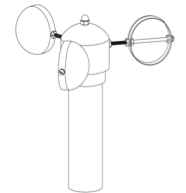Weather Instruments
1. Rain gauge: Is a fixed diameter so that they
collect the same amount of water & so comparisons can be made.
• Made of a hollow cylinder (C) containing:
• Funnel (A) to collect the water.
• A container to collect the water. This might be
graduated or water can be poured into a measuring cylinder. It is emptied once
every 24hrs at the same time. Rain is measured in millimetres.
• Is sunk into the ground, but not level with the
surface so that splashes or surface water cannot get into it.
2. Maximum-minimum thermometer: Records max. & min. temps. over a 24hr
period.
• Maximum thermometer contains mercury the minimum
contains alcohol.
• As temperature rises mercury expands & pushes up
a metal index when it cools & mercury contracts the index is left in place
at highest temp.
• As temperature falls alcohol contracts & pulls
metal index with it, but as the alcohol expands it flows passed the index
leaving it in place at the lowest temp.
• Both indexes are read once every 24hrs from the
bottom of the index.
3. Wet and dry bulb thermometer (hygrometer): Dry
bulb is a normal mercury thermometer it measures actual air temp.
• Wet bulb is the same but the bulb is covered with a
fine cloth which is connected to a reservoir of water.
Water evaporates from the cloth & cools the
temperature so it reads a few degrees lower than air temp.
4. Barometer: Measure air pressure.
• An aneroid barometer has a corrugated chamber
containing a vacuum.
• As air pressure rises & falls the chamber
contracts & expands.
• Levers conduct this movement to a spindle which
moves the pointer on
the dial which records the air pressure in mm of
mercury.
5. Anemometer: Measures wind speed.
• Three light rotating cups are blown around by the
wind the revolutions are counted & converted into; metres per sec.; km per
hour; knots etc.
6. Wind vane: Records wind direction.
• The fang is blown by the wind so that the arrow head
points into the wind.
• Both are mounted on a high pole.
Stevenson’s Screen: Contains the thermometers.
• Painted white to reflect the sun with a double lid
for insulation.
• Slatted sides to let the air circulate, but slanted
downwards to prevent light getting in.
• Legs 1m long to prevent heating from ground.
• On short grass so it’s standardised i.e. same amount
of reflectivity.
Cloud types:
Cumulus: These clouds usually have flat bases lumpy tops
& distinctive boundaries.
Cumulonimbus: The cloud type associated with a thunderstorm
& heavy rain, (at high levels cooled water droplets convert to ice
crystals).
Altocumulus: These clouds are a good indicator of medium
level instability and high moisture content -and often the precursor for
widespread thunder activity within the following 24 to 48 hours.
Stratocumulus: Low-level cloud type, varying from thin, well
broken layers with little impact for general weather, to deep, sometimes
unstable character, and a risk of moderate turbulence & moderate icing.
Little rain.
Nimbostratus: Heavy cloud layer, often dark in appearance.
Often combined with continuous falling rain/drizzle or snow
Stratus: Are thin-layered clouds
• Are low to the earth’s surface
• Look like stripes or streaks in the sky.
• No rain.
Cirrus: Thin because they form in the higher levels of
the atmosphere where little water vapor is present. No rain. Made of ice
crystals
Locating weather stations
- They should be on
short grass. (Concrete reflects heat, tarmac absorbs it.)
- They should be in an
open area away from obstacles like buildings & trees so there is no
shade or protection from the wind or rain
Weather symbols
Cloud cover is measured in
eighths: Hold the sheet directly
above your head & estimate the cloud cover directly above you.










No comments:
Post a Comment